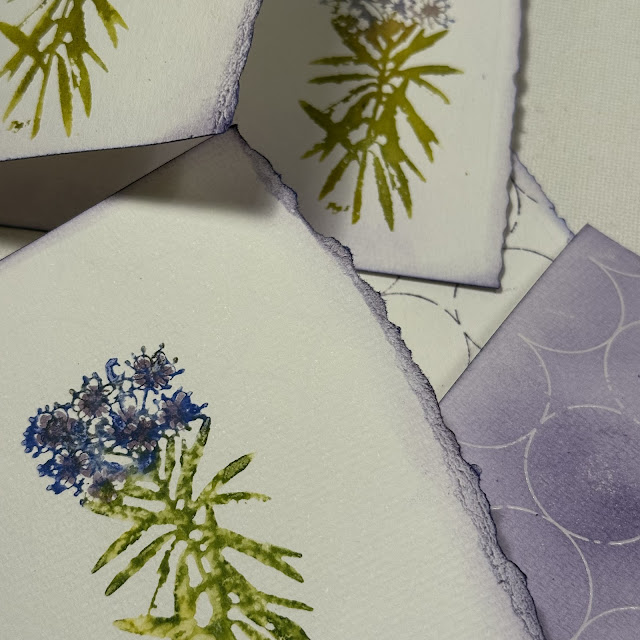This year on the blog, we have free reign to do a deep dive into a PaperArtsy product ranges of our choosing. For this post I have been exploring the PaperArtsy Eclectica products (EPA02, PS449). These stamps and stencils were released earlier this year (January 2025) and have a really nice mixed media vibe. I just love using them in backgrounds to create some graphic interest. For this project I have paired them with a few of the PaperArtsy: Ink & The Dog Mini stamps, botanicals in particular. List of PaperArtsy stockist can be found here.
Today I'm looking forward to sharing with you how I used the same stamp to achieve both positive as well as negative image for a background. I also explored different ways to create a watercolored stamped image. Mostly, I enjoyed playing around with these wonderful stamps (and stencil) and created a fun botanical bound journal.
I love incorporating natural elements into my work, and the PaperArtsy Ink & The Dog mini stamps (MN67, MN68, MN69, MN70, MN71) led to the idea of using a natural floral stem to create the binding for my journal.
Using water reactive inks and flooding the inked stamps before pressing to create the image created such a beautiful watercolored look. Depending on the amount of water I spritzed, I could create a watery abstract or a detailed impression. These variations on the same stamp design resulted in a lot of interest!
My original plans for this journal involved focusing on one of the PaperArtsy Ink and the Dog Mini floral stamps, but I had a difficult time choosing just one, so I used all five, giving each design its own signature within the book.
My neighbor has a wildflower garden at the street that I pass each day. When I gathered my supplies to create this journal, I remembered seeing some of the same flowers in the garden. These were predominantly purple and so the color scheme was born. When lavender and iris flowers were also in the stamp collection, I knew that this color scheme was meant to be. While any type of water reactive medium could be used, I focused on primarily the Ranger Distress palette.
When making a handmade book, one of the initial steps is deciding the size. This includes the number of pages. Since this was my first attempt at making a piano hinged book, I wanted to keep it fairly small. This also worked well since I was using the mini stamps. Each Signature of the book contains three folded pieces of standard watercolor paper. There are five signatures, one for each of the flower designs.
I wanted the first page of each section to be a bold representation of the floral image. For this I used Ranger Distress watercolor pencils. I wet the tip of the pencil and added the dense color to the stamp. I then spritzed the "colored" rubber stamp with water and then created the impression. A couple of the designs are narrower than the others, like the lavender; for these flower designs, I did multiple impressions.
With all of the signatures having a designated flower, I was excited to fill up the additional pages. I noticed how differently the images appear depending on the amount of spritzed water used and decided that I would love to experiment with that on the next pages, only using the stamps with inks and water.
To complete the remainder of the first pages of each signature, I chose one of the graphic design stamps from PaperArtsy Eclectica Stamp Set 02 (EPA02). Wanting to keep with the boldness of the watercolor pencil impression, I inked up the image and added random marks onto the paper. I find it easiest to do this type of stamping without a stamp block. By simply using the stamp loosely in your hand, it is simple to press only on a small area, and to rotate the image freely.
I especially love how the pages look abutted to one another when the three sheets are folded into each other to create the book.
There are many tutorials online for how to make piano hinge books. This was the first time I have attempted to use this type of binding, and surprisingly, it was not too difficult. I suggest making a sample before using your finished signatures to ensure it all goes together well. I also suggest perhaps using something a bit more durable to secure the pieces together. My vision was to use these lavender stems and while I did make it work, I am not sure how well it will last when the book is opened and closed a lot. I do however, love the way it turned out!
I love the finished project, especially with the vellum piece that adorns the cover. I used the distress watercolor pencil technique for the intense colored floral stamping and then stamped the graphic dots on the reverse side of the vellum. A stamp from Alison Bomber's PaperArtsy Set 21 (EAB21) onto the handmade, stenciled cover provides the perfect verse for inspiration.
Thanks for stopping by,
Ann





























.png)

No comments:
Post a Comment